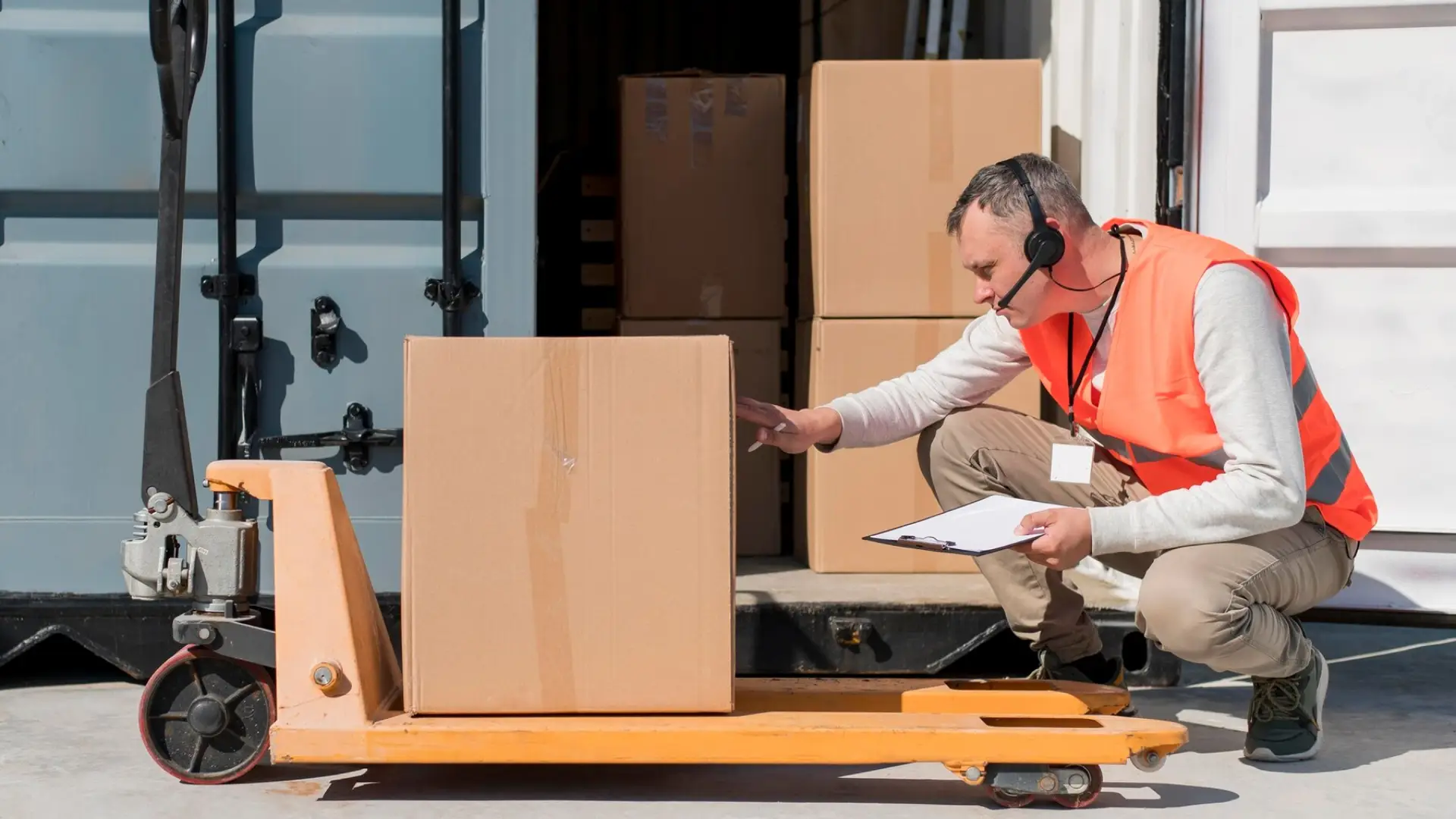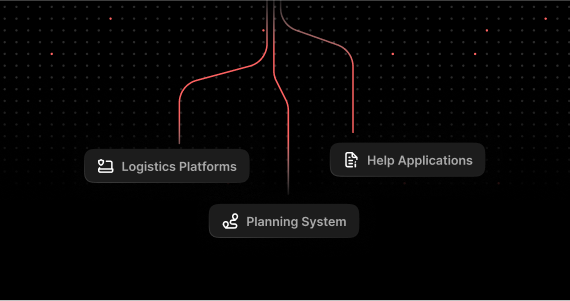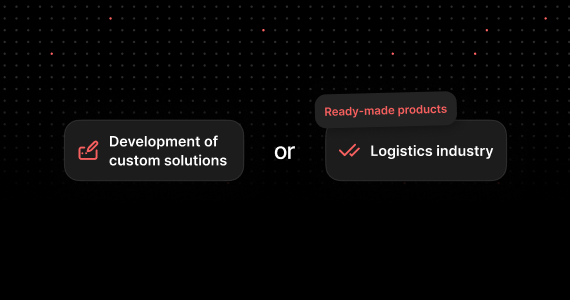Streamlining operations: the power of Logistics software development
The evolution of technology has greatly influenced the logistics industry, transforming the way processes are carried out. Logistics management software plays a crucial role in automating the movement of goods, services, and information throughout the supply chain.
In this article to logistics management software development, we will explore the concept of logistics management software and its potential advantages for your business. We will delve into the essential features and technology utilized in web development for logistics management software. Also, we will delve into the steps involved in constructing development logistics management software, while sharing practical case studies and insights from Solar Digital, a reputable logistics software development company specializing in custom solutions.
The main question: what is Logistics software development?
We have started our article with a brief introduction to logistics software development, discussing its scope and impact. Now, let’s expand the concept of logistics software development further.
Logistics software development are thriving sectors that enable efficient production methods. Companies rely on logistics software solutions to streamline their supply chain and manufacturing processes. These solutions automate various tasks, such as warehouse management and end-user delivery, while also facilitating information coordination, stock management, transportation, and packaging. By partnering with logistics software companies, businesses can access tailored solutions that foster growth and meet the ever-evolving needs of customers. It involves harnessing the power of technology to revolutionize the way businesses manage their supply chains, ensuring faster, more reliable, and cost-effective operations.
Future trends in the logistics software industry
The primary focus in the development of logistics software solutions is always to achieve better efficiency at lower costs. There are several global trends in software development for logistics:
- Utilization of big data. In custom logistics software development, the incorporation of big data into analysis, planning, and solution design is becoming increasingly common.
- real‑time tracking. This trend already exists in logistics software applications and is expected to grow in the future. It enables tracking of shipments, packaging, manufacturing, and delivery in real‑time.
- Scalability. The future of the logistics industry lies in scalable solutions. Custom logistics software development agencies create software that addresses specific business needs.
- Integration of advanced technologies. Custom logistics software development services are increasingly incorporating advanced technologies such as AI. This enables automation of processes like warehouse management and establishes efficient transportation routes. Cloud computing is also utilized to make programming more affordable and flexible.
Based on the data from Statista, the global market for supply chain management software is continuously expanding and is expected to surpass a value of US$10.17 billion by the year 2025. The growth in this market can be attributed to the increasing demand for efficient supply chain management solutions across various industries. As businesses strive to optimize their operations and improve productivity, the adoption of supply chain management software becomes essential.
The advantages of logistics software development for business
What does logistics software involve and how can it benefit businesses? In simple terms, such applications enhance efficiency. Employing services for developing logistics and supply chain software can also minimize issues like miscommunication, transportation errors, and human errors.
The advantages of software development for logistics and operations management are outlined below:
- Cost savings. Logistics software can help businesses save money on various expenses. By utilizing the system’s precise calculations, companies can identify areas where money is being spent unnecessarily, find ways to cut costs, and discover better deals on goods and services. Optimizing resources and routes, eliminating human error, and streamlining paperwork all contribute to cost reduction.
- Minimized errors and mistakes. The human element has a significant impact on business operations. People can be prone to errors or provide subpar customer service. By implementing logistics software, companies can effectively handle shipment situations in real‑time and optimize inventory control, minimizing the chances of human error.
- Enhanced supply chain transparency. In the past, customers would book shipments and wait for a phone call to get updates. With modern software, customers can now access and track their order’s shipment information whenever they want. Companies can also monitor internal and external operations using tracking software, ensuring that objectives are met and transparent relationships are established with all participants in the supply chain.
- Streamlined workflow. Once you have logistics software in place, you can input all your company’s paperwork into the system. This gives you complete control over the system and allows for easy retrieval of required documents through machine learning technology. Digital solutions help eliminate time-consuming manual tasks, optimize document management, handle inquiries, and track payments.
- Optimized resource allocation. Logistics software enables companies to regulate and manage logistics capacity effectively. It allows for monitoring the appropriateness of transportation usage and the efficiency of vehicle delivery. By utilizing vehicle tracking technology, managers can analyze driver workloads and identify reasons behind delays, leading to better resource allocation and improved operational efficiency.
Required functions of logistics software development
To ensure effective operation, logistics management software should incorporate specific functions. The following is a list of key functionalities that should be included in your logistics software solutions in order to achieve optimum efficiency.
- GPS tracking. GPS tracking is an essential tool that allows you and your clients to monitor the movement of shipments in real‑time. This feature is incredibly practical, as it keeps both you and your clients constantly informed about the status of their cargo, including its current location and estimated arrival time at the pickup location. With GPS tracking, you can ensure a smooth and efficient transportation process.
- System of notification. A notification system is a vital communication tool in the world of logistics. It serves as a means to provide updates and information to recipients. Such systems play a crucial role in modern transport management software, keeping everyone involved updated and alert about the shipment process, system updates, and more. Implementing a robust notification system, you can enhance communication and improve overall efficiency.
- Creating documents. Incorporating document and report creation features into your logistics software can greatly enhance your operational efficiency. By centralizing all contracts and agreements in one location, you can easily filter and access the relevant ones whenever needed. Generating reports allows you to obtain up-to-date information on various aspects of your business, such as recent profits or the number of shipments sent over the previous six months. These features streamline your workflow and facilitate data-driven decision making.
- Calculation shipping rates. Accurate assessment of shipping costs is crucial for the financial health of your company. By carefully calculating shipping rates, you can avoid offering rates that are too low, which could negatively impact your profitability, as well as rates that are too high, which may result in losing customers. Implementing a robust calculation feature enables your customers to quickly determine the amount they need to pay for shipping, promoting transparency and helping your business thrive.
- Two-factor authentication. To ensure the security of your logistics software, it is highly recommended to consider implementing two-factor authentication. With this additional layer of protection, only users who successfully complete two rounds of identity verification can gain access to the system. By keeping the login information for your software private and secure, you can safeguard sensitive data and protect your business from unauthorized access.
- E-payments. Offering the option of online payments can significantly enhance the convenience for your customers. Enabling them to pay for delivery online, you eliminate the need for physical payments and provide a seamless experience. Whether they are stuck in traffic or relaxing at home, your customers can conveniently make payments, speeding up the delivery process and improving customer satisfaction.
It’s important to note that each feature discussed above plays a critical role in creating an efficient and customer-centric logistics software. By incorporating GPS tracking, a notification system, document creation, accurate delivery calculations, two-factor authentication, and e-payments, you can optimize your operations and create a seamless experience for your clients.
Technologies used in logistics software solutions development
When it comes to developing logistics management software, different types require specific technology. Selecting the appropriate tech stack for your logistics solution is critical and requires a deep understanding of your business operations, target market, and the automation and monitoring tasks required. The chosen technology will dictate scalability, expansion expenses, the level of difficulty in integrating with other applications, and ultimately impact the future of your company. Let’s explore some of the key ones:
- Front-end development is responsible for creating the user interface that interacts with the logistics software. It involves using programming languages such as HTML, CSS, and JavaScript to design and build visually appealing and intuitive interfaces. The application’s visual components will be built using these languages in conjunction with frameworks like React, Angular. js, Vue. js or any other framework. Front-end developers also ensure seamless user experiences by implementing responsive designs that adapt to different devices and screen sizes.
- Back-end development focuses on the behind-the-scenes functionality of logistics software. Back-end developers work with server-side technologies such as Python, Node. js, Java, and PHP to handle the business logic and data processing. They design and optimize databases, write APIs for data retrieval and manipulation, and ensure the smooth flow of information between different components of the software.
- Cloud technologies have revolutionized the logistics industry by providing scalable and reliable infrastructure. This flexibility allows for easy scaling as per demand, ensures data redundancy, and enhances the overall performance and security of the system. In order to develop logistics software that will be used in the cloud, you can use the following technology: Node. js and NET.
- Mobile development has become increasingly important in logistics software due to the growing use of smartphones and tablets in the industry. Mobile apps enable logistics professionals to access real‑time information, track shipments, and manage inventory on the go. Technologies like Swift for iOS and Kotlin for Android are used to build native mobile apps, while frameworks like React Native and Flutter enable cross‑platform development, reducing time and effort.
- The use of APIs (Application Programming Interfaces) is crucial in logistics software. APIs facilitate seamless integration with external systems such as shipping carriers, payment gateways, and warehouse management systems. They enable the retrieval and exchange of data, automate processes, and enhance the overall efficiency of logistics operations.
To ensure the successful development of logistics software, a combination of these technologies is often employed. Front-end development creates visually appealing interfaces, while back-end development handles the core functionality. Cloud technologies provide scalable infrastructure, and mobile development caters to the increasing need for mobility. APIs enable integration with external systems, streamlining logistics operations.
Stages of development of logistics software: step by step
The development of logistics software involves several key stages that are crucial to creating a successful and efficient system. Each step builds upon the previous one, ultimately leading to the final product. Let’s explore these stages in a step-by-step manner:
Step 1: requirement analysis. The first stage is to analyze the requirements of the logistics software. This involves understanding the needs of the business or organization and translating them into specific software features. It includes gathering information, conducting interviews, and documenting the requirements.
Step 2: system design. Once the requirements are clear, the next step is to design the system architecture. This includes creating a blueprint of how the software will function, the modules it will have, and how they will interact with each other. It also involves designing the user interface and database structure.
Step 3: development. The actual development of the logistics software takes place in this stage. During the crucial stage of development, translating the design into a functioning product is key. This process is divided into several steps. Firstly, technical documentation is created, gathering all the necessary information and finalizing the estimated scope of work. Next, the development phase begins, with team members assigned specific tasks based on their expertise. Front-end and back-end developers focus on their respective areas, while the DevOps team handles the CI/CD process. After development, QA engineers conduct thorough testing.
Step 4: testing and quality assurance. After the software is developed, it goes through rigorous testing to identify and fix any bugs or glitches. This stage ensures that the software meets the specified requirements and functions as intended. Quality assurance techniques, such as regression testing and user acceptance testing, are employed to ensure a high-quality product.
Step 5: copywriting. It involves creating compelling texts, before the product moves forward to the launching stage. Well-crafted content adds value to the product and helps effectively communicate its features and benefits to potential users.
Step 6: integration. For a successful integration process, it’s important to take the necessary steps. First and foremost, invest time in training your employees. In order to fully utilize the potential of logistics software, it is crucial for your firm personnel to have a comprehensive understanding of how each component of the system functions. It is advisable to establish connections between your software and all the services you utilize. This ensures seamless coordination and efficient operations.
Step 7: maintenance and support. After deployment, the software requires ongoing maintenance and support. This includes fixing bugs, implementing updates and enhancements, and providing technical assistance to users. Regular monitoring and performance optimization are also carried out to ensure the software runs smoothly.
Each step plays a crucial role in the overall development process, ensuring the success of the software solution.
How much does it cost to develop logistics software in 2023?
Developing logistics software in 2023 can vary in cost depending on various factors such as the location of the outsourcing company and the specific requirements of the project. According to a reliable source, the average rates of developers, QA professionals, and designers in outsourcing companies across different regions are as follows:
- In Europe, the average hourly rates range from $50 to $150 for developers, $30 to $70 for QA professionals, and $40 to $90 for UI/UX designers.
- In America, the average hourly rates range from $60 to $180 for developers, $35 to $80 for QA professionals, and $45 to $100 for UI/UX designers.
- In Asia, the average hourly rates range from $30 to $80 for developers, $20 to $50 for QA professionals, and $25 to $60 for UI/UX designers.
It’s important to note that these rates are estimates and can vary depending on the complexity of the project, the experience of the professionals, and other factors. It is always recommended to consult with outsourcing companies directly to get an accurate quote based on your specific requirements and desired outcomes.
Reasons to use the services of Solar Digital company
Solar Digital has a team of highly skilled professionals with extensive knowledge and experience in the digital industry for more than 7 years. We are experts in their respective fields and can provide top-notch solutions to meet your specific needs. The company stays up-to-date with the latest trends and technologies in the digital world.
We understand that every business is unique, and therefore, they tailor their services to fit your specific requirements. Also, we take the time to understand your goals and objectives, ensuring that the solutions they provide are customized to meet your business needs.
Solar Digital values customer satisfaction and strives to exceed their expectations. Our company prioritizes open communication, timely delivery, and providing excellent customer support throughout the project lifecycle.
One of the proofs of our expertise and reliability in logistics software development services is the case of our client Stark Shipping.
Stark Shipping is a company based in Ukraine that has been providing port agency services to maritime logistics companies all over the world for over 8 years. Solar Digital and Stark Shipping have been partners in the field of IT and digital solutions for maritime logistics for a long time. We have been working together since the beginning of Stark Shipping and have developed several collaborative maritime IT solutions. These solutions have helped our clients establish themselves as innovative maritime logistics agencies in the highly competitive maritime shipping market.
One of our impressive solutions is Stark Research 4.0, an analytical tool that benefits various stakeholders in the maritime market. These stakeholders include shippers and receivers, maritime shipping companies, port agents, port governors, ports and terminals, independent stevedores, governmental entities, fleet operators, financial holdings, freight transport companies, 3PL and 4PL companies, construction companies, charter companies, oil brokers, grain traders, quality control laboratories, and any other maritime professionals. This tool provides them with comprehensive information about vessels and ports, including real‑time shipping tracking maps.
Conclusion
The integration of logistics management software has proven to be crucial in enhancing the efficiency and effectiveness of logistics operations. By automating various processes and providing real‑time visibility into supply chain activities, businesses can streamline their operations and gain a competitive edge in the market.
Logistics software development is a thriving sector that leverages technology to optimize supply chain processes. By embracing these solutions, businesses can achieve faster, more reliable, and cost-effective operations, ultimately driving growth and customer satisfaction.
At Solar Digital, we understand the significance of logistics software in the maritime logistics industry. That’s why we have established a long-standing partnership with our clients, combining their expertise in IT and digital solutions with our port agency services.





